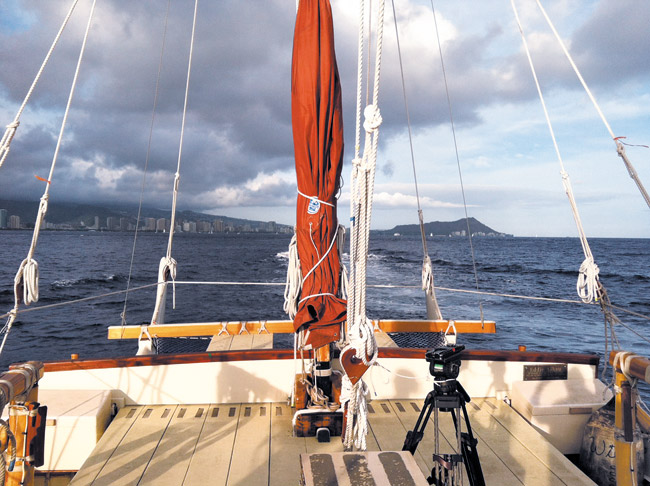Sailing Aboard The Hokule‘a
It was an opportunity of a lifetime, a chance to sail on the Polynesian double-hulled voyaging canoe Hokule’a. I was fortunate to join more than 20 educators from Punahou School for Hokule’a’s final “community sail” before she would leave for the much anticipated worldwide voyage.
Others felt the same way. “This is important for all of us tonight,” says Malia Ane, director of Hawaiian studies at Punahou, of the evening sail with fellow teachers. “It’s important that we touch Hokule’a, that we feel her, that we see the crew, so that when we return to our classrooms and talk to our students, our lessons come from our hearts.”
Mother Nature greeted us with near-ideal sailing conditions: light tradewinds, relatively calm seas and eventually, a full moon. We left the Marine Education and Training Center at Sand Island May 24 just after 5 p.m. and headed toward Diamond Head. I sat in awe as the seasoned crew raised her sails. The double-hulled vessel cut swiftly through the surf. We were gliding and I was in heaven.
“She’s much faster now,” says master navigator Nainoa Thompson as we both stared off into the horizon. It was a special moment. I knew I was standing with one of Hawaii’s finest leaders, a man who studied non-instrument navigation under master navigator Mau Piailug of Satawal, Micronesia.
And then, Thompson blew my mind.
“Thank you for coming, Ron,” said Thompson.
I quickly responded, “No, Nainoa, thank your for having me aboard, and thank you for all that you’ve done.”
Hokule’a spent several months on dry dock, where much work was done on her hulls and deck box. Solar panels on the vessel were repositioned, its rigging was re-lashed and she was repainted. In all, an estimated 2,200 volunteer, professional and labor hours were put into the refurbishing project.
“It’s an investment in the earth, it’s an investment in the future, it’s an investment in keeping tradition, resources, knowledge and learning alive for future generations,” says crew member Lehua Kamalu.
Since its first long voyage in 1976 from Hawaii to Tahiti and back, Hokule’a has sailed an estimated 135,000 nautical miles throughout Polynesia, Micronesia, Japan and the West Coast of the United States. The worldwide voyage will be its longest journey.
Hokule’a and her sister vessel Hikianalia are scheduled to leave Oahu in early June, and they’ll spend the first year in the Pacific Ocean. Over three years, they will visit more than 60 ports in more than 20 countries. Thompson says the mission of the worldwide voyage is “to navigate toward a healthy and sustainable future for ourselves, our home and our Island Earth.”
“This voyage intentionally is supposed to honor, supposed to celebrate, and it’s supposed to strengthen all cultures on the planet by respecting them,” said Thompson.
As the sun began to set, we turned outside of Kahala and headed back toward Waikiki. A full moon was off in the distance and soon lit up the evening sky. It was a cloudless night as we drifted under the stars and planets.
“There’s Hokule’a,” said several teachers, pointing to Arcturus, a guiding zenith that passes directly overhead at Hawaii’s latitude. “It’s so bright.”
We spent the next hour learning about the different stars and planets from crewmember Jenna Ishii. Other crewmembers spoke with excitement about their upcoming journey and expressed great pride about being physically, emotionally and spiritually prepared. I have no doubt they are more than ready.
Hokule’a pulled into the Marine Education and Training Center shortly after 9 p.m. Our remarkable night of sailing and education had come to an end, but not before receiving a gift from Thompson and his crew: the gift of hope.
Imua Hokule’a!
rkmizutani@gmail.com






